VALORANT Data Drop: Phantom vs. Vandal
The VALORANT Data Drop (A.K.A., the article formerly known as Data Breach) is back! And this time we’re taking aim at an always hot topic of debate within the community. Which rifle reigns supreme—Phantom or Vandal?
Well, as you might have guessed, we’ve got some ‘splaining to do. And lots of data to back it up.
For this article, our team of numbers wizards, better known as the VALORANT Insights Team, pulled detailed queries from a mix of more than 4 million unrated and competitive matches across all ranks.
So let’s dive in.
Wins for the Phantom
Near-Sighted
If you find yourself taking a lot of close-to-medium-range gunfights, the Phantom might be your friend…or gun buddy?
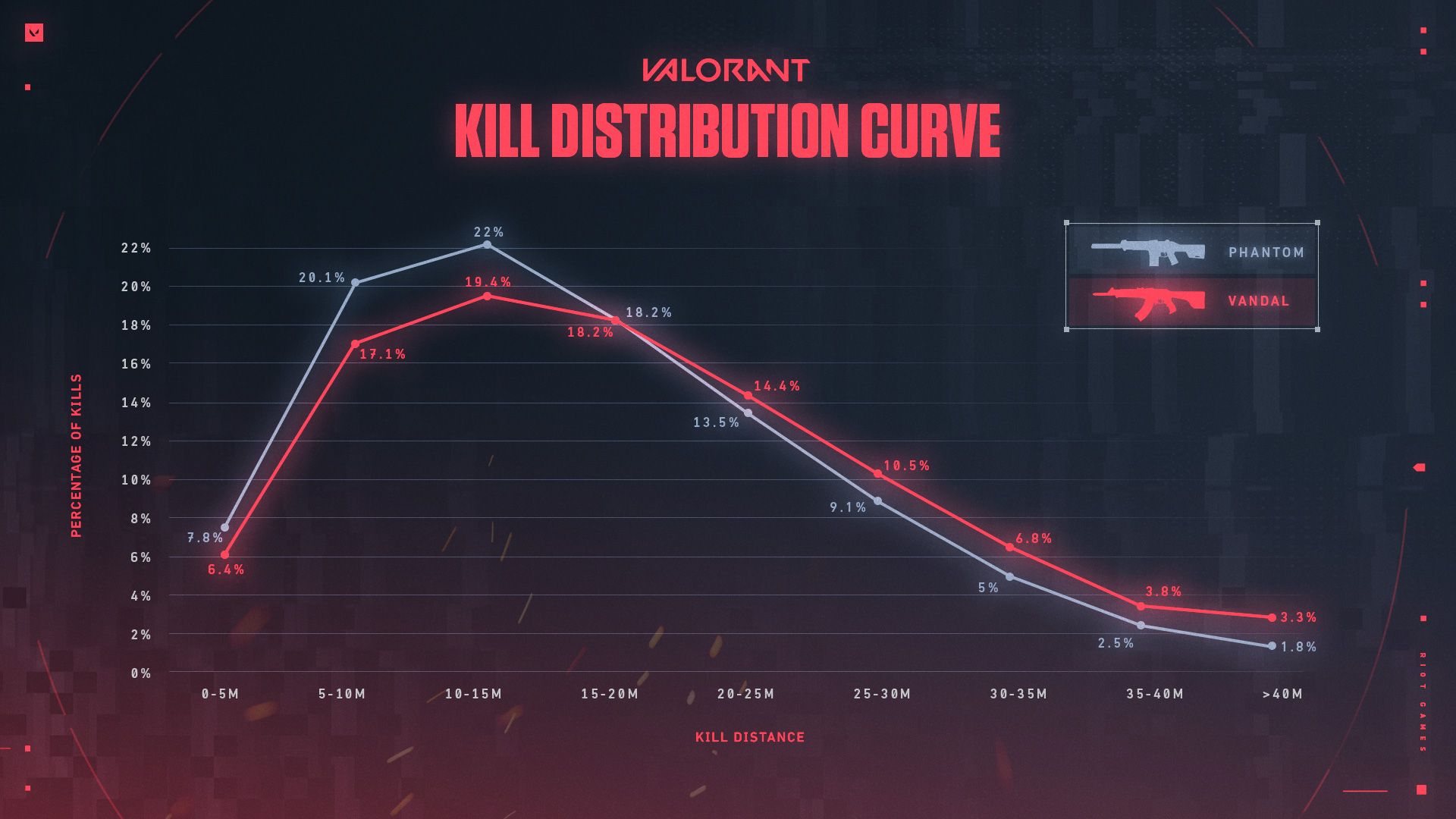
In this line graph, we see the total number of each weapon’s kills broken out by distance in 5 meter increments. Each point on each line represents a discrete distance bucket and its correlating percentage of kills. From this, we saw that a majority of the Phantom's kills occurred within a range of 15 meters while the Vandal’s kills have a more consistent arch across all ranges.
For reference, 15 meters is about the distance when peeking the corner from the end of the attacker-side hallway on Ascent’s B main to the defender’s main entrance.

Disclaimer: The weapons in the graph above are labeled incorrectly. Phantom numbers are shown in red and Vandal numbers are shown in blue, contrary to the legend. Apologies for any confusion.
To show this kill distribution a little more simply, we can also put these kills into the three range buckets we’ll be using throughout this article, 0-15 meters, 15-30 meters, 30+ meters. This is where the Phantom’s close-range advantage starts to become apparent. Nearly half of all Phantom kills took place within 15m.
While the Vandal still has plenty of stopping power at close range, the Phantom seems to be the short-range specialist for a few reasons we’ll discuss.
Spray and Pray
A weapon’s spray pattern in a tactical shooter is a complex discussion. First shot accuracy, second shot accuracy, bullet spread, recoil recovery, number of rounds fired, number of hits, etc. all play a part in tracking how efficiently a weapon can get kills while spraying down the enemy team.
To simplify this, the Insights team was able to calculate for a weapon’s spray control using time as a factor. Multi-kills within 5 seconds act as a good, real-world proxy for spray control—especially in 3K and 4K situations where aiming, firing, pausing, and resetting your crosshair for each kill would be tough in that time window.
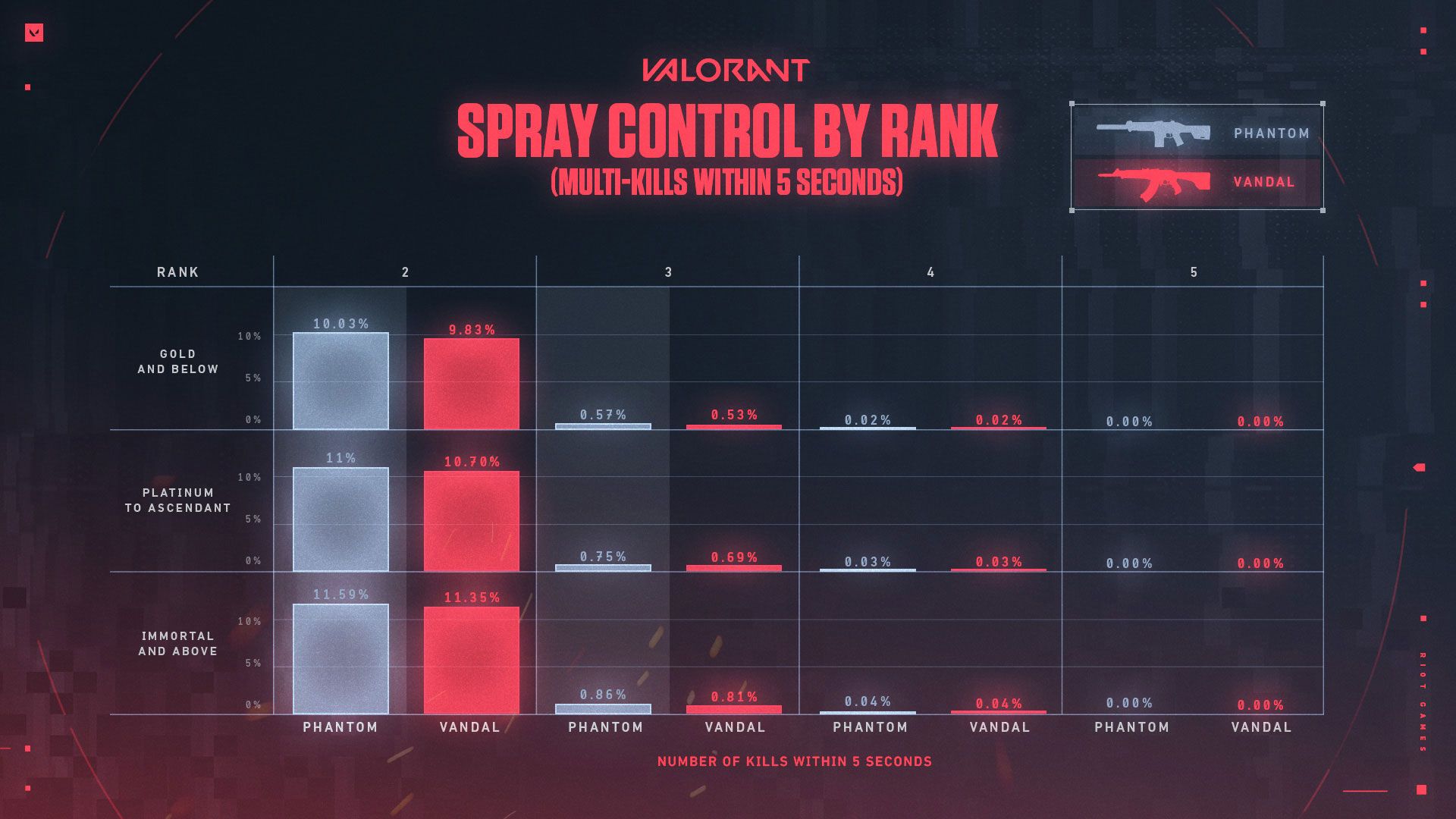

In the graphs above, we see how many multi-kills the Phantom and Vandal were each able to rack up within a 5-second time window. (Note: Percentages do not add up to 100% since we’ve omitted single kill scenarios from these graphs.)
And once again, the Phantom reigned supreme in multi-kill situations within 15 meters. This further proves Phantom’s spray control dominance, as spraying tends to only be effective at short range. We also see that the Phantom performs better in 5-second multi-kill scenarios across all ranks. So whether you’re hardstuck Iron, or trying out for VCT, the Phantom seems like your best choice in close-range spray scenarios.
Don’t Get Close
Ok, so we know that the Phantom thrives in short-range combat. But what about in heads-up duels with a Vandal user? Who takes the title of short-king (or queen)?

This graph shows that the Phantom beats the Vandal in close-range, heads-up gunfights. The Phantom’s close-range supremacy holds true across all ranks, even though this advantage slightly decreases as your rank gets higher.
Wins for the Vandal
Pick Your Poison
We wanted to see which rifle players favored and by how much. We had a small hunch that the Vandal would come out on top for this one. And sure enough it did.
For the purposes of this study, we measured players’ primary loadouts. We define primary loadout as the weapon that players purchased in all rounds excluding pistol, eco, bonus, and OT rounds. We found that players in competitive queue choose the Vandal more than any other weapon in the game as their primary loadout.

And when looking at data from all the VCT matches so far in 2023, we see that pro players also tend to favor the Vandal. While the Vandal still tops the charts in pro play, pro players do tend to adopt the Phantom at a higher rate than players in competitive queue.
So why is the Vandal such a fan favorite?
Clicking Heads
Everyone knows there are plenty of ways to get a kill. But more often than not, a headshot will likely make the difference between a kill and an assist.
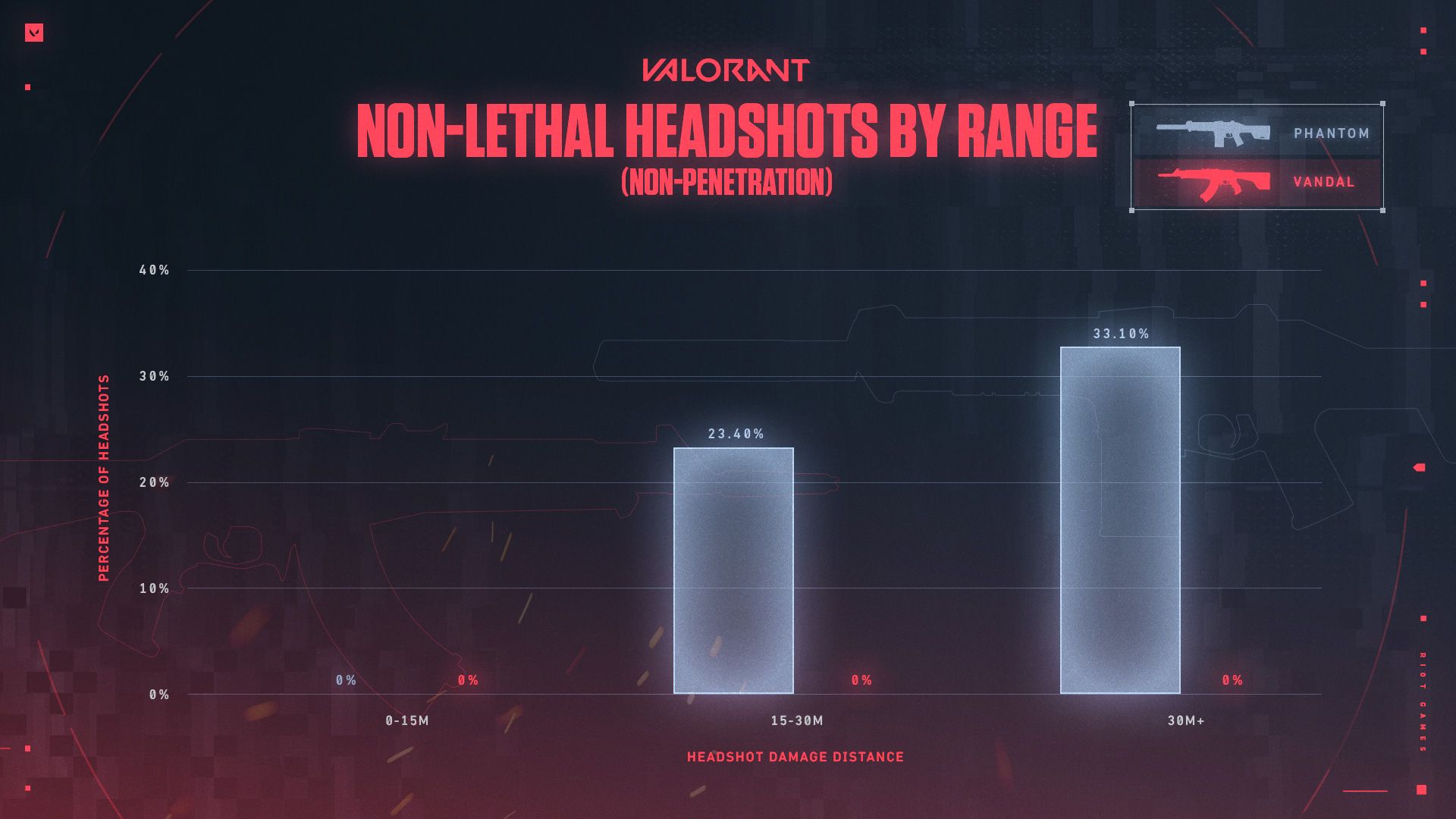
So for all you overachievers out there, headshots are clearly one of the Vandal’s strong suits. In this graph, we see the percentage of nonlethal, non-penetration headshots, AKA “dinks,” by range. In case you’re wondering, non-penetration means the shot did not travel through an object. Occasionally, we see nonlethal headshots occur when some of the damage is negated by passing through objects like walls, boxes, or doors.
For the Vandal, the number of times a headshot doesn’t kill a target remains consistently 0%. That’s because a Vandal headshot does 160 damage at any range without penetration. But for the Phantom, the percentage of headshots that don’t kill their target rises dramatically at range.
Another way to think about this is with a “what-if” scenario. So the team looked at these kinds of engagements specifically.
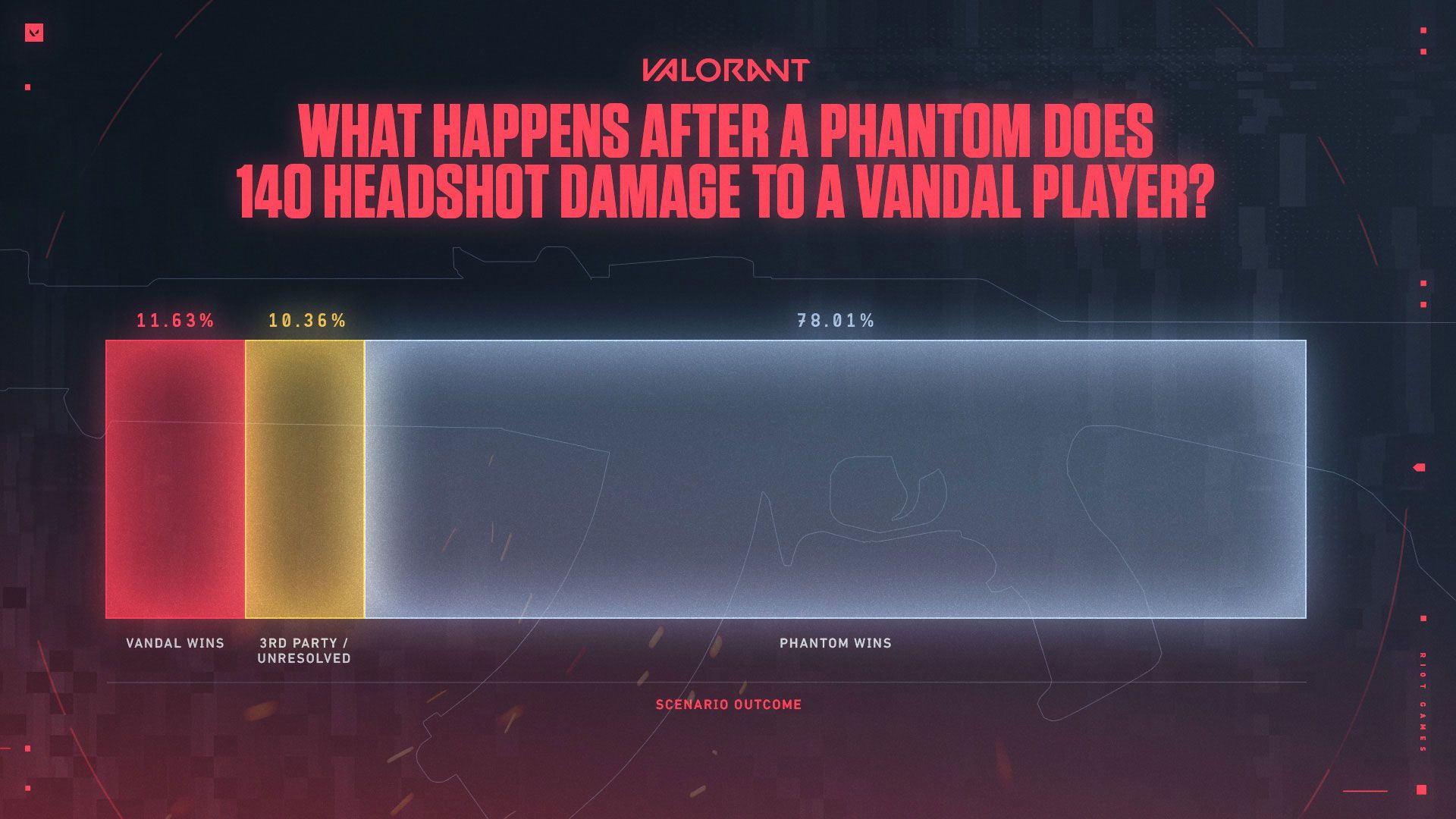
The Phantom does 140 damage to players between 15-30 meters. These situations are when the damage feels so close to 150 that players really start to regret their purchase and wonder, "What if I bought a Vandal?"
The actual data shows that if a Phantom user manages to do 140 damage on a Vandal user at 15-30 meters, around 78% (blue) of the time, the Phantom still ends up killing the Vandal player.
10% of the time (gold) a teammate either comes in as a "3rd party" to the fight or that fight just isn't resolved until later by someone else—resulting in an assist for the Phantom user.
The remaining 11% of the time (red) the Vandal actually manages to turn and kill the Phantom player. This 11% is where if your headshot had done 150 damage, you would have never died.
Deadeye
So if the Vandal is getting more headshot kills, is it a more accurate weapon? Or does it just do more damage?
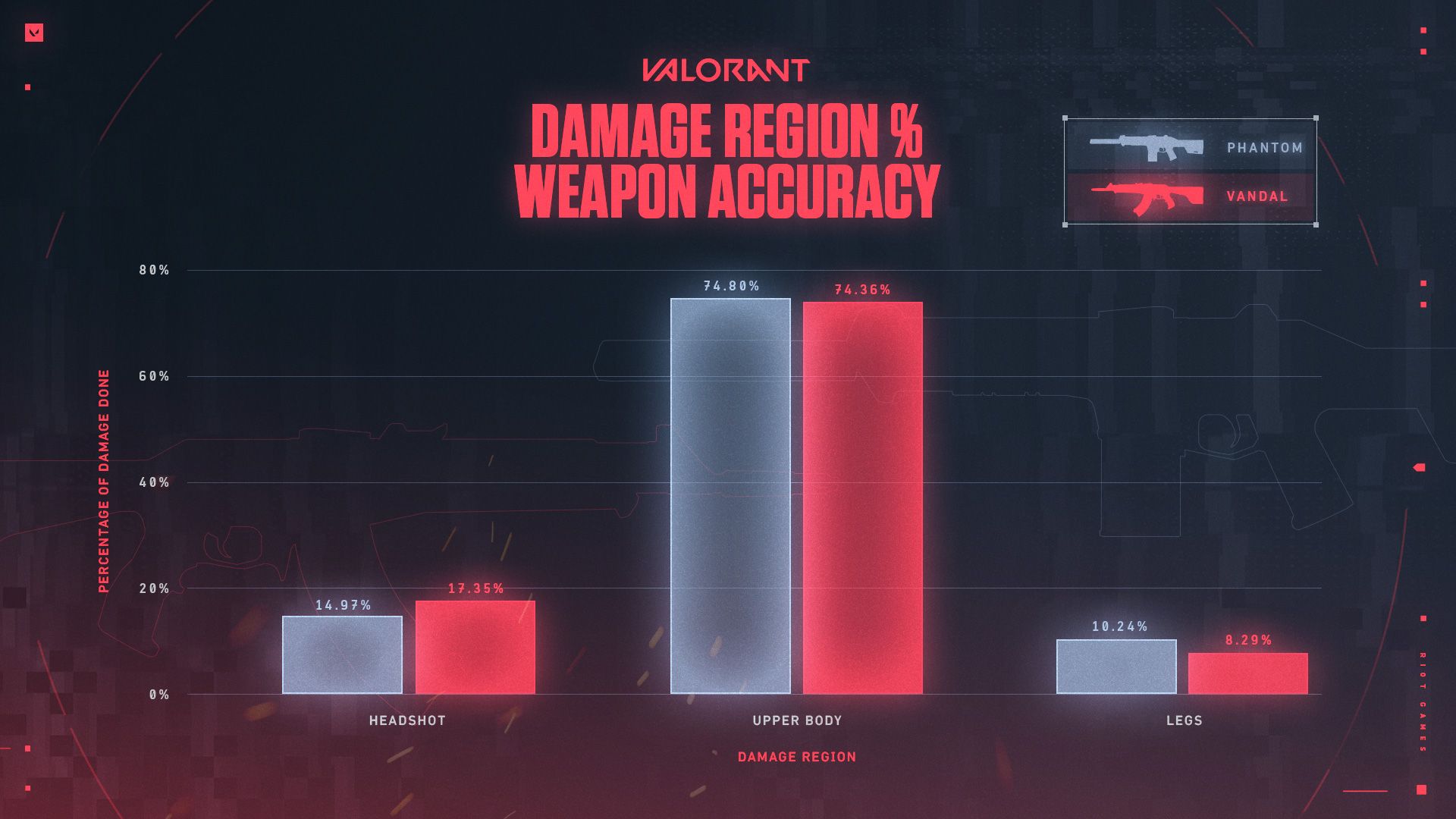
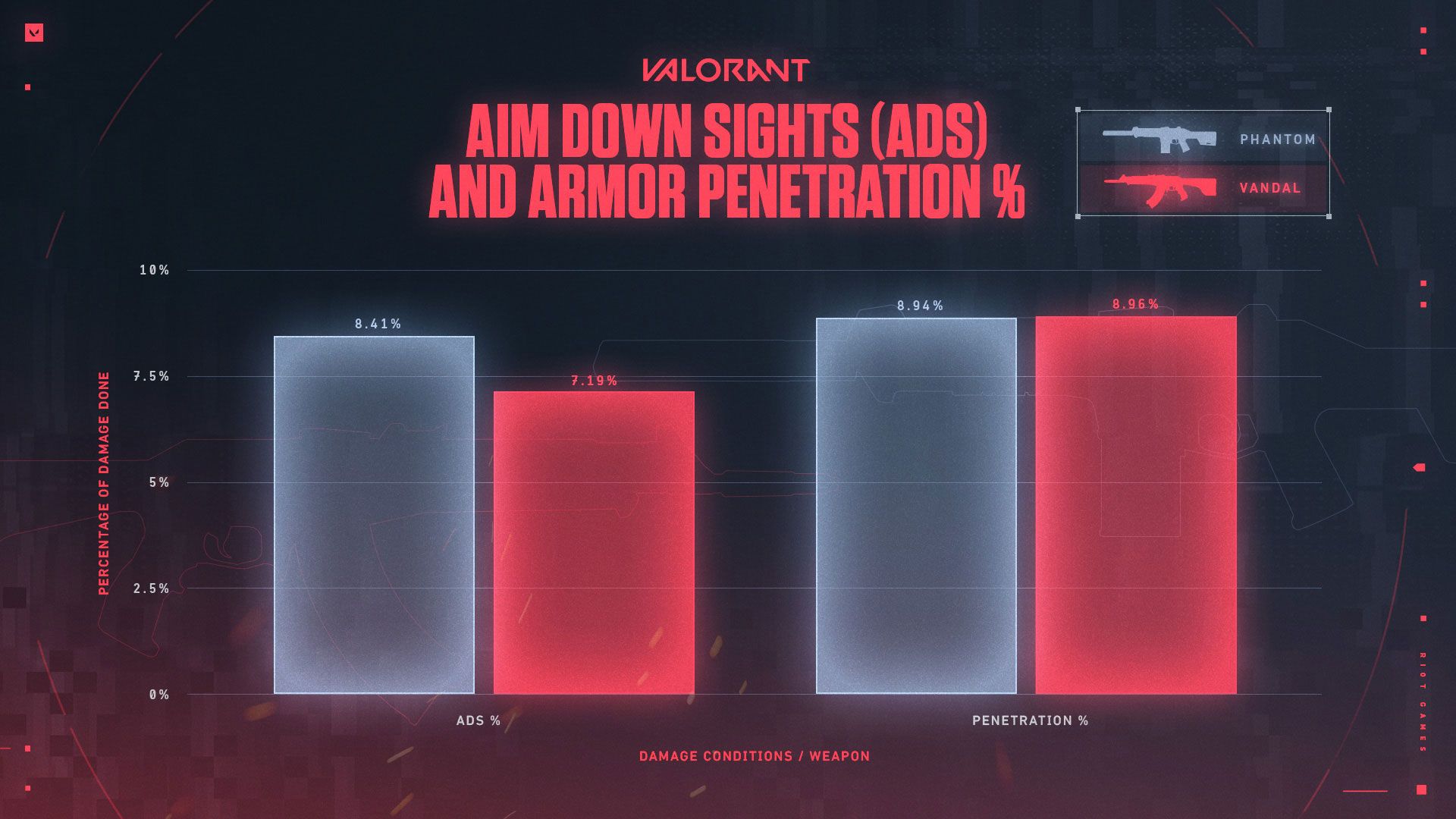
These graphs show the overall damage breakdown of each weapon by region, ADS, and armor pen. We see that the Phantom actually lands more shots to the body and legs than its rival rifle, but the Vandal takes a little more off the top with a higher percentage of headshots.
This could be because of the Phantom’s higher rate of fire and the potential of a non-lethal first headshot. So players tend to have a wider window to hit more body and leg shots while the Vandal only needs one headshot to end the duel with a guaranteed kill. It’s safe to assume that Phantom players probably go for a little more than a one-tap at most distances, even in ADS, which is likely why the amount of damage during ADS is higher on the Phantom.
Armor Piercing Rounds
How does armor factor into each rifle’s lethality?
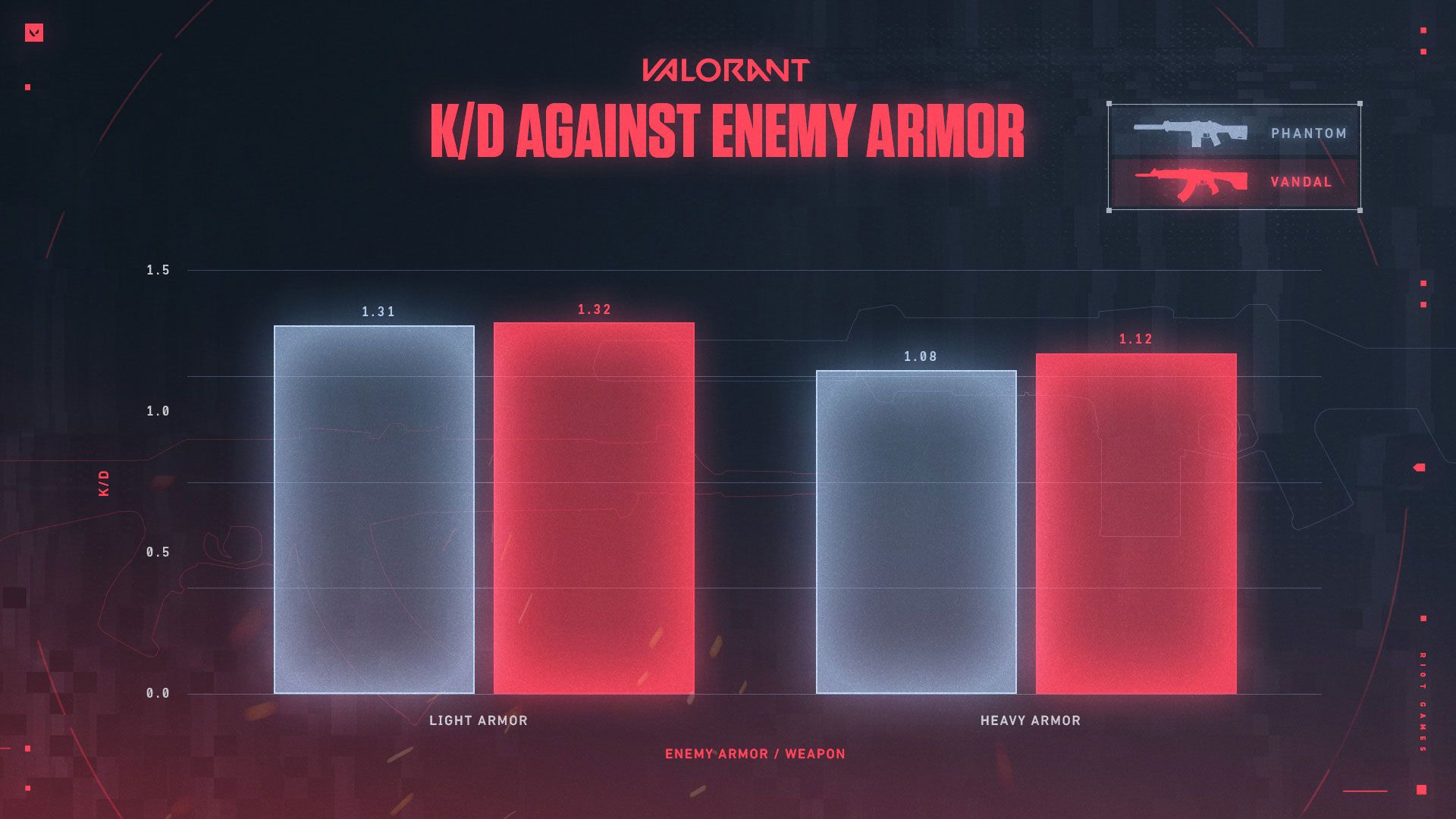
For a good indicator on real-world performance against armor-wearing opponents, the team compared the K/D (kills/deaths ratio) for each weapon when against an enemy wearing equal armor (e.g., light armor Phantom user vs. light armor enemy, heavy armor Vandal user vs. heavy armor enemy, etc).
They found that the Phantom performs almost equally as well as the Vandal against light-armored opponents, but falls to heavy-armored enemies more often than Vandal users. This makes perfect sense when considering the previous damage region % graphs. The Phantom typically lands more body shots and non-lethal headshots which isn’t the greatest of situations against an enemy in heavy armor. So buy your armor, folks!
The Verdict
It’s all subjective.
If you’re consistently clickin’ heads, the Vandal might be for you. If you’re a little more spray and pray, try the Phantom.
Also, what kind of gunfights do you like to take? Are you a nearby angle-holder and/or smoke-spammer? Go Phantom. Or do you like to pinpoint your shots from longer distances? If so, go Vandal.
We asked Carson Dowhan, one of our Insights Team Researchers for his final word on the topic, and here’s what he had to say,
“It really does boil down to your playstyle and confidence as a player. When in the heat of the moment using a Phantom, the average VALORANT player doesn't think to themselves ‘As long as they're less than X meters away, I have a slight advantage statistically.’ If they do, then they've clearly watched their Woohoojin VOD reviews.
Both the Phantom and Vandal are viable in most situations. As long as you understand how to play to the different strengths of each rifle, you'll be fine. Besides, I think game sense determines a win more than raw accuracy—but that's something that's really difficult to measure.”